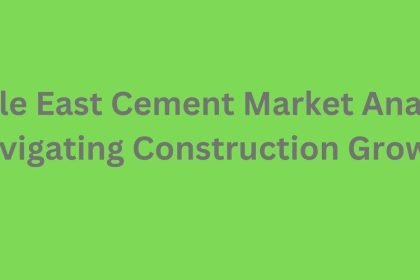Middle East Cement Market Analysis: Navigating Construction Growth, Supply Challenges, and Market Opportunities

The Middle East is renowned for its dynamic construction sector, reflecting a combination of population growth, urbanisation, and extensive infrastructure development. Central to this construction boom is the cement market, a critical element in the region’s ongoing economic transformation. In our latest market analysis, we analyse the Middle East market in-depth dissecting the intricacies of the construction industry, supply-demand dynamics, and the multifaceted opportunities and challenges it presents.
The Middle East’s construction sector is marked by a multitude of dynamic activities
Infrastructure Development: Governments across the region are channelling substantial resources into infrastructure projects. These projects encompass airports, ports, roads, and railways, reflecting a forward-looking approach to expanding and modernising transportation networks. The Riyadh Metro in Saudi Arabia and the Neom projects stand as a testament to the scale and ambition of these investments.
Urbanisation: Rapid urbanisation is profoundly shaping the region, fostering the development of residential, commercial, and mixed-use complexes. Cities like Dubai, Abu Dhabi, and Doha are undergoing significant expansion, causing a continuous cement flow to facilitate construction projects.
Mega Projects: The Middle East has garnered global attention through iconic projects such as the upcoming World Expo 2023 in Dubai, the ambitious Red Sea Project in Saudi Arabia, and the construction of Qatar’s FIFA World Cup 2022 stadiums. These mega projects serve as catalysts, driving considerable cement demand.
Reduced Dependency on Oil Revenues: Historically, many Middle Eastern economies heavily depended on oil revenues, which could be volatile because of global oil price fluctuations. The diversification away from oil is a deliberate strategy to mitigate economic risks and create more sustainable sources of income. As governments invest in various non-oil sectors, such as tourism, technology, and manufacturing, they stimulate demand for infrastructure and real estate development, thus driving the demand for cement.
Demand and Supply Dynamics
The Middle East cement market operates amidst a unique set of challenges and opportunities:
Demand Growth: Cement demand in the region is poised for sustained growth. Factors such as population growth, robust infrastructure investments, and urbanisation fuel this upward trajectory. Cement consumption is expected to exhibit steady growth in the coming years.
Supply Constraints: Cement production in the Middle East faces historic and persistent challenges. Limited access to critical resources, high energy costs, and environmental concerns hinder the expansion of local production capacities. Many countries within the region rely on cement imports to bridge the supply-demand gap.
Environmental Concerns: Increasing global awareness of environmental sustainability has placed the Middle East cement industry under scrutiny. Pressure to adopt greener practices, including the reduction of carbon emissions, efficient water usage, and waste minimisation, is mounting.
Market Competition: The Middle East cement market is characterised by fierce competition. It is home to global conglomerates and influential local players, such as the Saudi Cement Company. These competitors vie for market share, intensifying the landscape.
Opportunities and Challenges
The Middle East cement market offers a complex interplay of opportunities and challenges:
Green Cement: A significant opportunity lies in investing in sustainable and environmentally friendly cement production methods. These include innovative practices such as using alternative fuels, carbon capture technologies, and waste reduction. Companies that embrace these practices not only reduce their environmental footprint but also secure a competitive edge.
Export Potential: Leveraging the region’s strategic geographic location, which bridges Europe, Asia, and Africa, provides export opportunities for Middle East cement producers. These companies can expand their reach by capitalising on their competitive advantages.
Infrastructure Investments: Governments’ continued investments in infrastructure projects across the Middle East offer substantial growth prospects for the cement industry. The persistent growth in these projects ensures a steady demand for cement products.
Energy Costs: The energy-intensive nature of cement production in the Middle East exposes the industry to fluctuations in energy prices. These variations can significantly impact production costs and overall profitability for cement manufacturers.
Overcapacity: In some countries, overcapacity challenges arise, leading to intense price wars and compressed profit margins for cement producers. Navigating these competitive pressures is essential for long-term success. However, some factories in war-torn countries, once rehabilitated, would add extra pressure on both the local and the regional markets.
Geopolitical Risks: The Middle East has historically been susceptible to geopolitical tensions, which can disrupt supply chains and negatively impact market stability. Mitigating these risks and ensuring business continuity is paramount for market participants.
The Middle East cement market remains intrinsically tied to the region’s construction activities and economic growth. While the demand for cement is set to rise due to sustained investments in infrastructure and urbanisation, the industry faces challenges related to sustainability, energy costs, and supply constraints. Cement manufacturers that innovate, adopt greener practices, and navigate these challenges effectively are poised to capitalise on the market’s substantial potential.
For a deeper understanding of the Middle East market, we invite you to explore our latest market outlook report on the Middle East Cement Market
